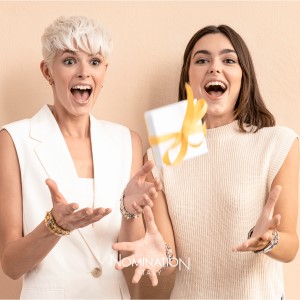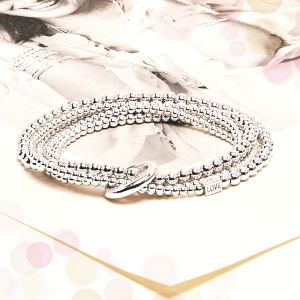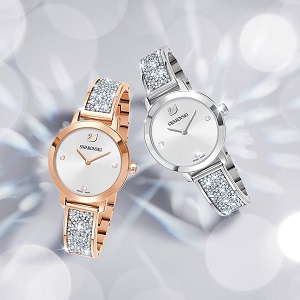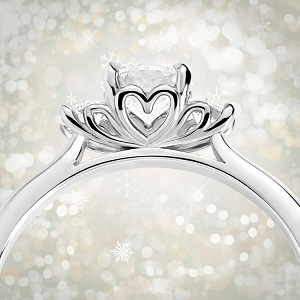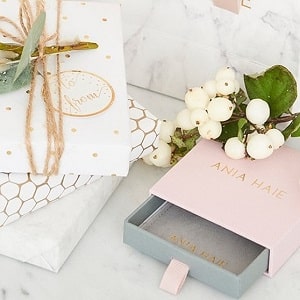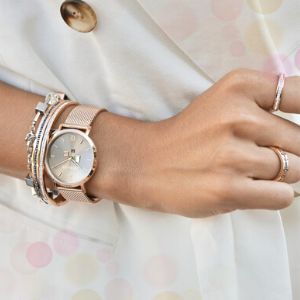20% Blue Light Card discount on full priced items
- Free UK delivery for orders over £25
- Complimentary packaging & gift message
- Express delivery £6.95
Making decisions on diamond jewellery
When it comes to choosing a piece of diamond jewellery, you need to consider a lot of factors. The 4 c's (carat, colour, clarity and cut) is only the beginning. There's also which metal to set it in, how much to spend, where to get the piece of jewellery. You also need to decide whether to have it custom made or buy off the shelf.
And then whether the diamond is responsibly sourced and where it actually comes from, and what certification to get. The considerations can seem overwhelming. But there's some good news - our cheat's guide to choosing diamonds like a pro, without the years of gemology training!
Study up
You don't need the gemology degree, but first and foremost do have a quick read of a short diamond guide. This will refresh your memory on the 4 c's and other basic considerations when choosing diamond jewellery.
Become familiar with the terms and what they mean. And think about anything you're not prepared to compromise on. For example, if your soon-to-be-betrothed has made it clear that anything under a 3/4 carat solitaire just won't do, put that on your list.

If you are choosing a second diamond ring to sit next to a ring you already wear, colour is important. You'll need to make sure it is of a similar enough colour that it won't show a difference. One step (eg, D to E) most often won't show a difference. But if you have a D colour diamond and you try to pair it with a H coloured eternity ring, there will be a visible colour difference. Each colour grading is still a range. So always check in different lights as the difference may be visible despite seeming close in colour.
If the ring is for the other hand, or the piece of jewellery is for the neck, wrist or ears, the exact diamond colour won't matter as much. You won't see a side by side view with other diamonds being worn. It's only when diamonds are next to each other that any colour difference can be easily identified. All diamond colours from D to I are considered white. It's only when you get to J colour and beyond that you start to notice yellow hues.
Set your budget
Sounds boring, but hear us out. It may be hard to believe, but the most important thing is how much you are prepared to pay for this piece of jewellery. Everything else is moveable to get the right piece of jewellery, but do decide first what your budget is.
It doesn't need to be an exact number, a range will do. But if you are looking for something under £2000, shopping a for flawless pure white one carat diamond engagement ring or diamond tennis bracelet is going to be challenging, to say the least!

Take a look online first at the type of diamond jewellery you are interested in. See what specifications you typically get for your budget. If it doesn't appeal, re-think either your needs or your budget. Definitely aim for a good deal, but also be realistic.
If you find something that is at the very top or a bit over your budget, you can ask the retailer if they would be prepared to give you a discount. It may not always be possible but it doesn't hurt to ask, especially when it's a large purchase.
Consider the occasion
Clearly the occasion for choosing a piece of diamond is important. Buy the same principles of diamond selection apply. Whether it's an engagement ring, an anniversary gift, to commemorate a milestone such as a graduation, or simply to treat yourself. The main reason the occasion is important to consider is when it is a surprise gift.
If you are commemorating a milestone or anniversary with diamond jewellery, but it's not a proposal, consider choosing earrings or a bracelet rather than a ring. For couples who already wear engagement and wedding rings, eternity rings are often given to commemorate the birth of a child, and for other milestones like a graduation or big birthdays, diamond earrings for women or pendants are a wonderful choice.

Weigh up quality vs size
Ask yourself - is diamond size or quality more important to the wearer? This is one of the key ways to get to the right budget for your diamond jewellery. It doesn't mean you have to choose something that is poor quality! But it may just mean choosing slightly less pure white diamonds or allowing slightly larger inclusions (flaws).
The flaws are not necessarily even visible to the naked eye without a magnifier or loop. From a distance or worn on a moving person, you don't see these unless they are particularly large.

Use common sense - if you can't see an inclusion (flaw) in natural light even when pointed out to you, it's almost certain that nobody else will. If you have always had a hankering for a completely flawless diamond, go for it. Your budget has to be higher than for the same size of diamond with some minimal flaws.
Think about branding
If the coveted ring or piece of jewellery is from a famous brand of diamond jewellery, you will likely pay a bit (or a lot!) extra for the name. The exact same diamond specification can cost quite a lot more than from a less famous designer. Brand names can be quite important to some people. This is entirely a matter of personal choice, but something to be aware of when setting your budget.

If you use a reputable local jeweller or lesser-known branded diamonds, the result will often be just as stunning and high spec for a considerably lower cost. So whilst the branding is very important to some, others would prefer to have a larger size or quality of diamond without the branding. And let's face it, brand will rarely be a topic of conversation after the initial opening of the piece.
Diamond certification details
There are several diamond certification bodies, one of the best-known authorities being GIA - Gemological Institute of America. This body also has laboratories, research centres and campuses all around the world. They produce a certificate that covers all the details about a diamond. This includes shape, measurements, carat weight, colour, clarity, cut, polish, symmetry and fluorescence. The certificate also lists the grading scales used for reference. The IGI (International Gemological Institute) is another reputable option.

Many loose diamonds already come with certification. So you may not need to go through this process, but it's worth knowing a little about it. On the other hand, GIA / IGI certification is generally only available for diamonds over 0.25ct and whiter than G colour. So eternity rings and tennis bracelets often won't be certified and this is completely normal. Just buy from a reputable jeweller or diamond dealer.
Feel confident about diamond origins
Conflict diamonds and diamond origins can be a big concern for diamond wearers. It's fun to know exactly which mine a diamond came from, but this isn't necessary unless you are particularly interested. The main thing to check when buying diamonds is that the supplier (the retailer and/or the brand) sources their diamonds according to the Kimberley Process.
The Kimberley Process started when Southern African diamond-producing states met in South Africa in 2000, to discuss ways to stop the trade in ‘conflict diamonds'. The process was formalised in 2003 as a commitment from 54 countries, including the UK, to remove conflict diamonds from the global diamond trade.
Diamonds sold here in the UK should be conflict-free. But if you are concerned, you can go one step further to ensure your diamond jewellery is responsibly sourced. Choose a reputable jeweller and ask for the country of origin and certification. If you order diamonds from abroad, check that the country is part of the Kimberley Process.

If you would like to know exactly which mine your diamond comes from, certain brands like Maple Leaf Diamonds go even further. They will provide a Canadian diamond 'passport' which tells you the date and location of mining. As for diamond certification, this tends only to cover the main solitaire diamond in a piece, or diamonds over a certain carat weight.
Consider Custom
Custom design may sound complicated, but it doesn't have to be. For many pieces of diamond jewellery, such as classic round brilliant diamond earrings, it's just not necessary. There are beautiful designs ready to buy at reputable local jewellers.
For wedding jewellery, it can be a lovely process. You can completely design your own bespoke piece and have it custom made. This is perfect if you want to be that little bit different. Or it can reflect something you've always wanted but can't find the exact thing. If this is you, read up on our blog on designing your own jewellery. The process is not nearly as daunting as many people think.
Many engagement, wedding and eternity rings will be custom made to order anyway. They may be based on a pre-designed piece or a sample. If you find a design you love and can try on a sample, it can be safer to work with that design rather than making too many changes to it. That way you know exactly how it will look. This way you 'just' need to choose the ever important diamond specifications to go in the dream ring design. It's still tailor made for you, but based on a design you know you love.

Phew! Now that you've completed the quick reference of diamond buying, happy diamond jewellery shopping!
Got questions? Contact us in store to speak with one of our friendly team members.

